Plans Change
Planned for a meeting at work this morning so I had to be in work for 6:45am and then left at around 9am to head to University. The meeting was finished earlier than I thought so I booked some equipment out to use in the colour darkroom, as Dan had previously said that he’d changed the chemistry in the Colenta machine.
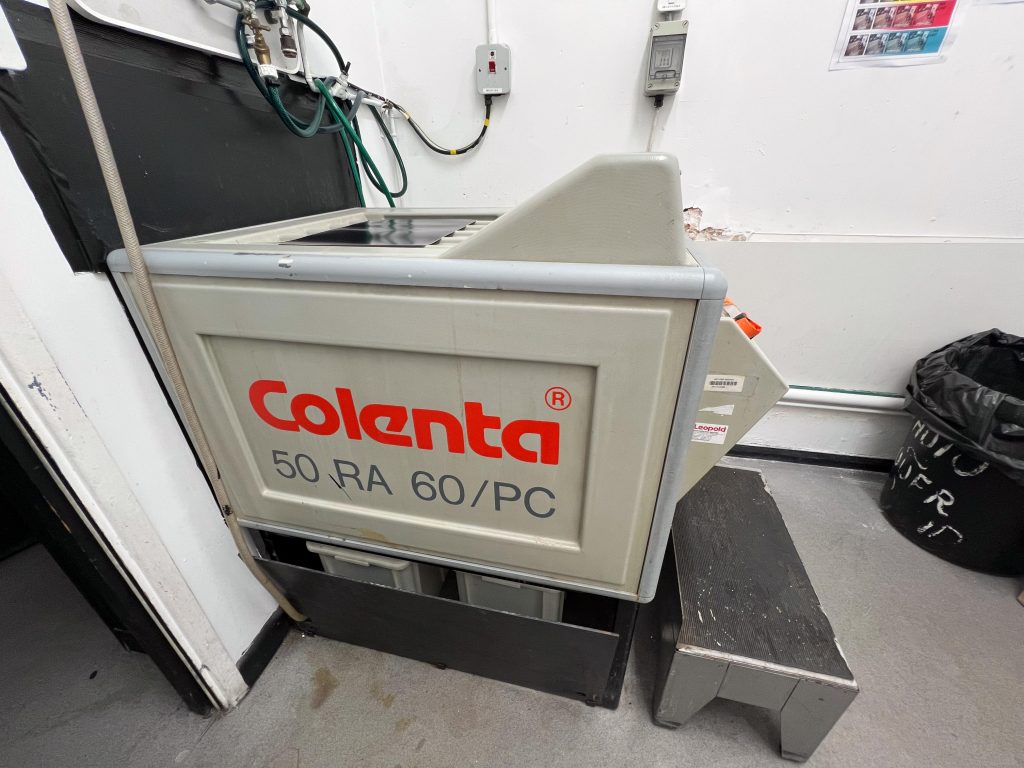
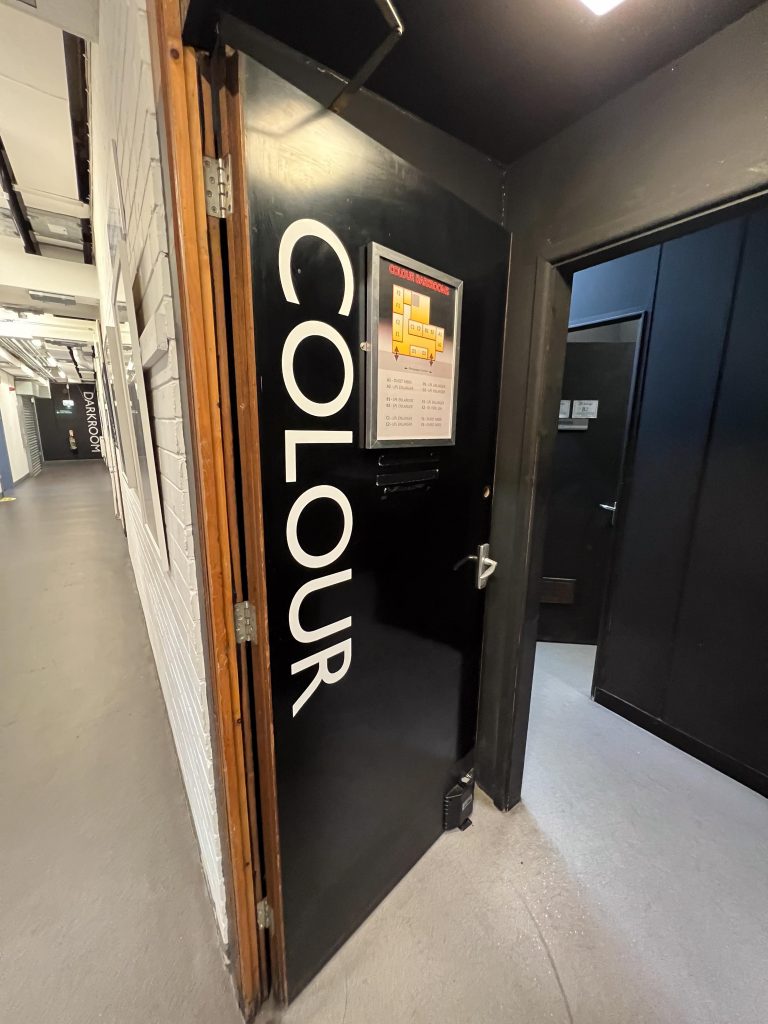
Colourful Start
When I got to the School Of Art, Dan was in the media stores already, sorted me out with the 120 and 35mm contact printers, a medium format colour kit and I was away into B2 to get on with some printing from the enlarger.
First up on the list was a repeat of contact sheets that I’d been trying to print over the previous few weeks with no success. With the new chemistry in the tanks it should be sorted and give me some good tone.
I emptied a negative sleeve of 120 Film 645 negatives on Portra 400 into the contact printer and began the test strips, full strips and full prints. I had to change the YMC Filters a little to remove the Magenta cast and went up to Y50,M70,C0 and all seemed to be working correctly, the colour cast was almost gone.
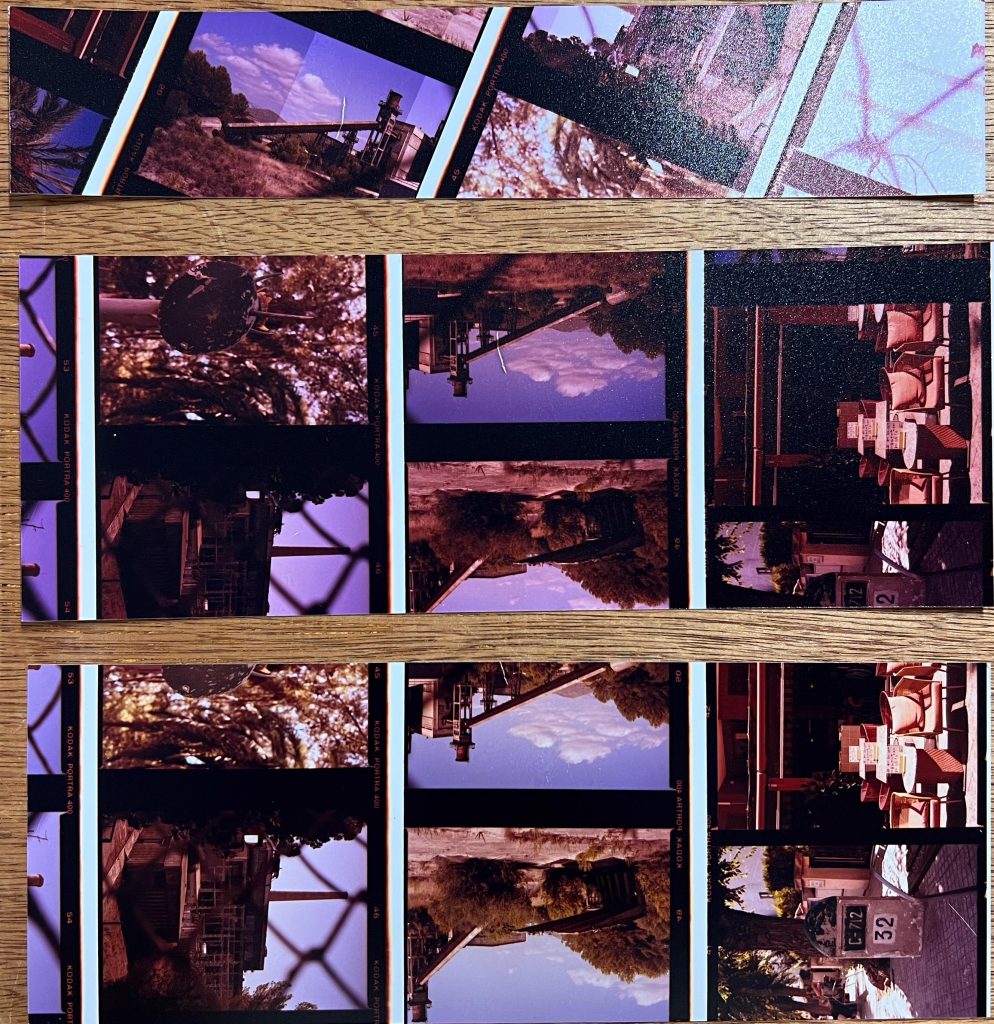
The blacks were really filling in this week and I was really happy with the outcome.
The first contact sheet for Film#60, a roll of Kodak Portra 400, was done and soon I was ready to do the next set of 120 negatives for film #59 which is Portra 800
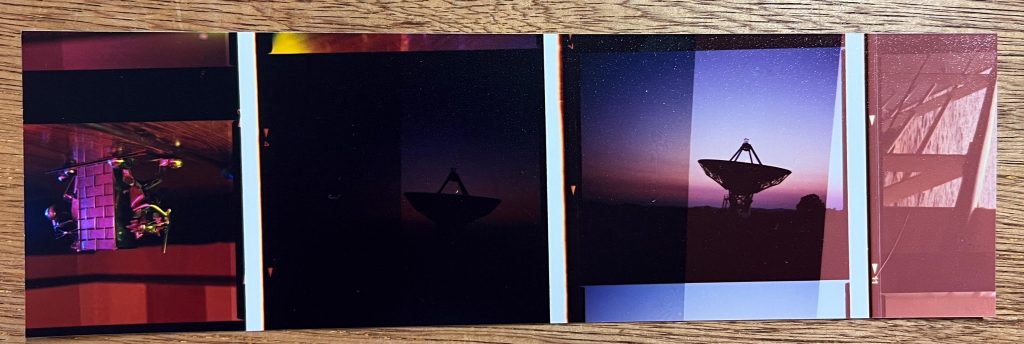
One test strip, shows the selection of 6 seconds so I hit it with a Full Print and this came out with the settings pretty well instantly.

Once I’d got the #59 Contact print out of the Colenta colour machine I wanted to choose a print that I’d tried last time in the colour darkrooms. I’d picked the negative showing a Radio Telescope in Knockin at night time. I needed to put the 80mm lens in the enlarger and swap out the negative holder.
With the scene showing on the easel at f4 I focussed using my focus finder and then tried a test strip. It was all black and needed another aperture but it seemed wrong. I wondered if the aperture might be faulty in the lens so I turned on the enlarger and then played with the aperture. Nothing changed and I had a grope around the lens and found a lever that when released allowed the aperture to go to the correct size.
I figured out after playing again with the lever that this must be a selector to allow the aperture to be changed in a smooth motion, then position changed to make the apertures move to clicked positions and then finally it holds it open so that it can be used for focussing. Once I’d figured out what this was for I was able to set it to clicky mode, and then watch as the image projected onto the easel was more faint when the aperture was closed down so I knew it was working correctly.
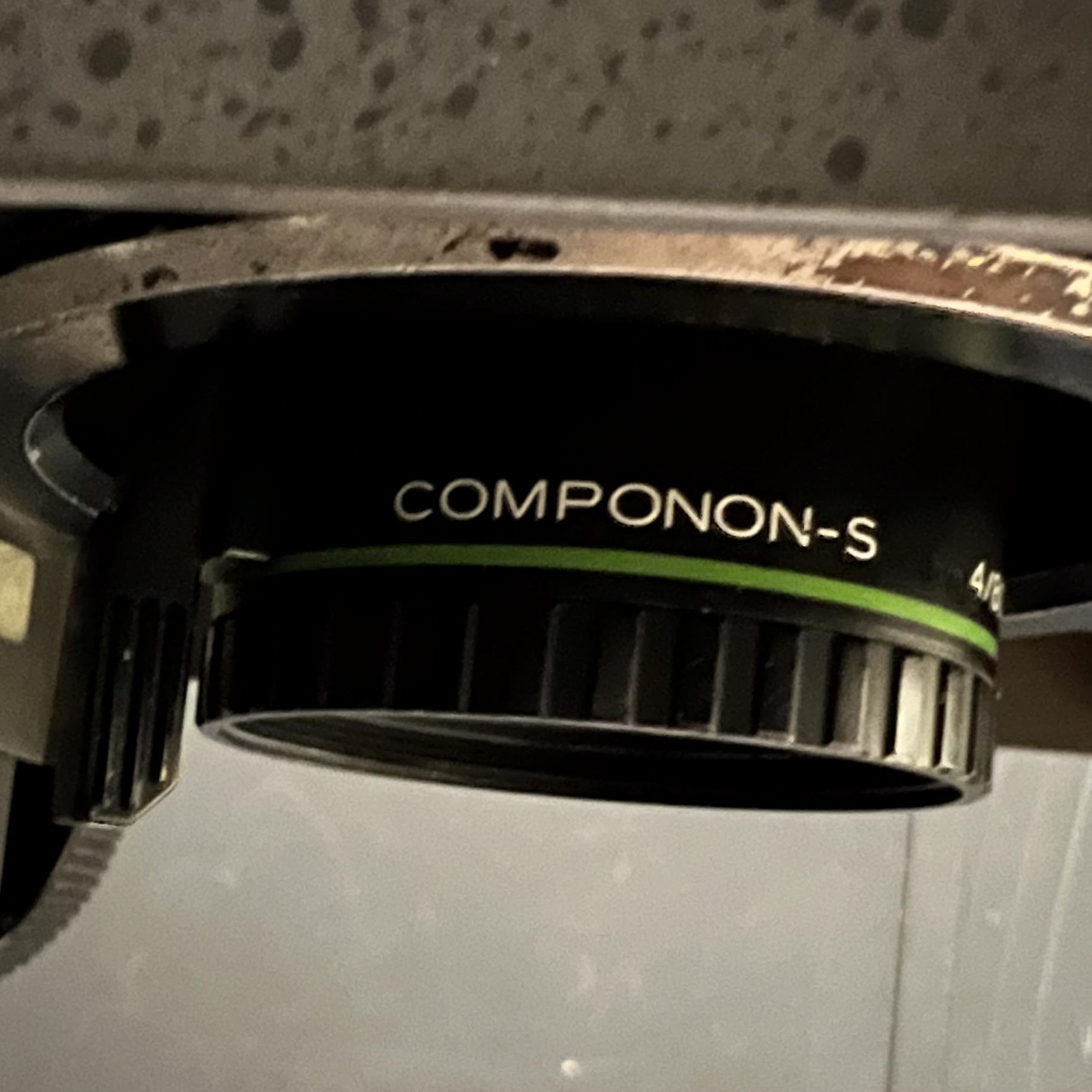
After this I got some good shots printed out and carried on printing another shot of a sunset from the cruise ship when we went on holiday in August, the first print I did had the pillars on either side of the frame so I wanted to take these out by lifting up the enlarger head and cropping the image.
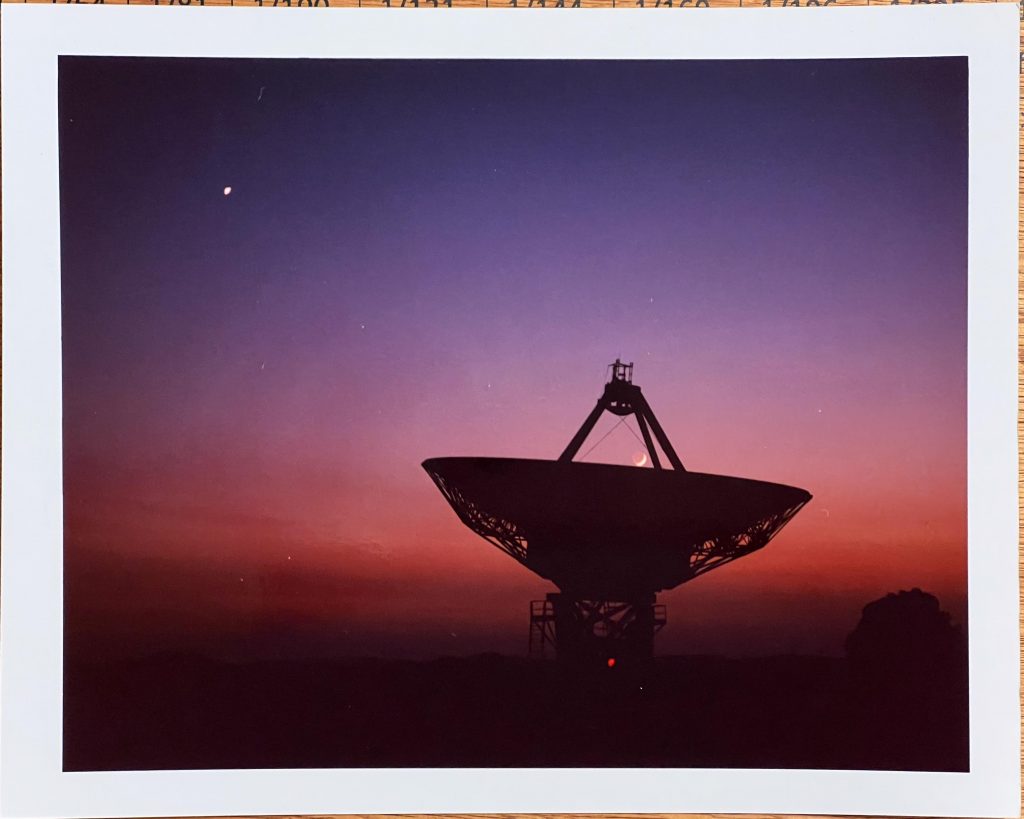
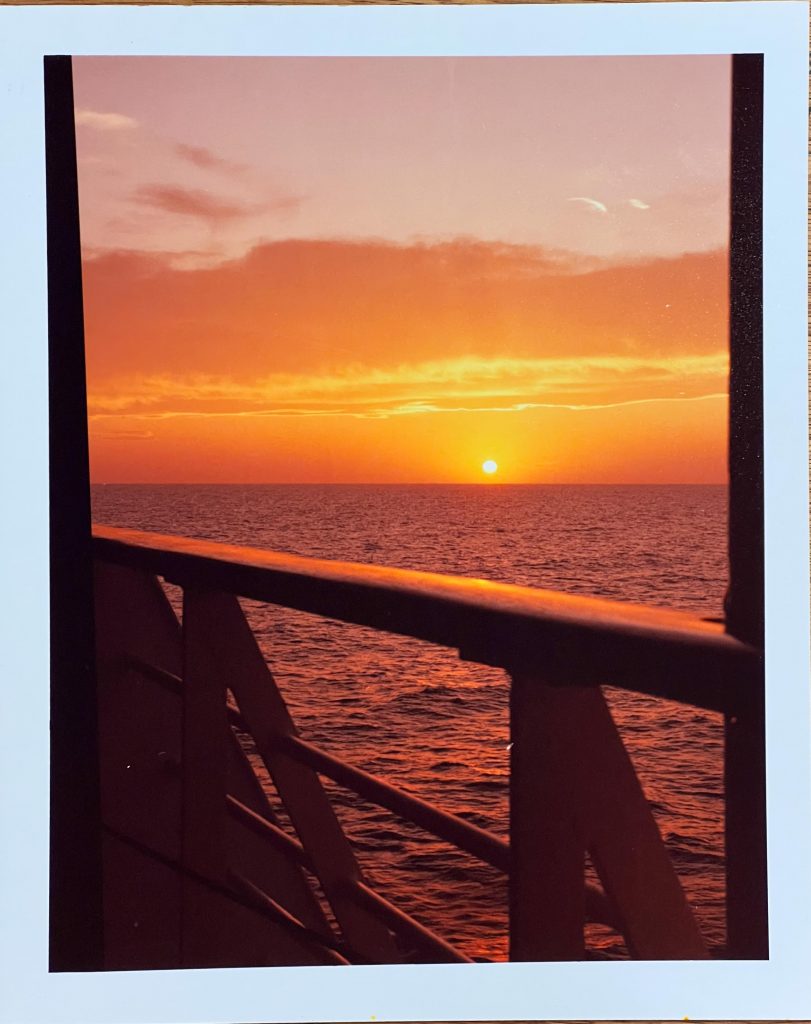
What I forgot was, by moving the enlarger head up, I’d effectively added distance and thus less light would make it to the paper. The first print I did, was very underexposed so I re did it a few times in a row, with the last couple of sheets of Fujifilm Crystal Archive Lustre.
I was pleased with the results of this week’s efforts after the issues I’d had with the chemistry in the Colenta over the last few weeks. The contact sheets are great and the few prints that I got out I was pleased with the image of the telescope and also the chimneys of the Alcudia power station.

Afternoon Session
In the afternoon, we all met in the lecture theatre for our discussions of our Contextual Essay Plans. We’d each setup a presentation and sent it to Sylvia who then shared them on a screen and allowed us to present to the rest of the group.
Presentations of essay plans
I was first up and spoke about my limited number of slides all based around the word “Atmosphere” I ran through my slides and asked for questions when Sylvia asked me to include references that I had already used to get as far as I have. I’d also mentioned that I will be writing an essay rather than the alternative of a visual analysis.

Sylvia asked if I will reference other people’s images and talk about my own images and I think that I will reference other’s images but I was only showing my images on these slides as my attempt to pass on the idea of how I feel I can represent an atmosphere.
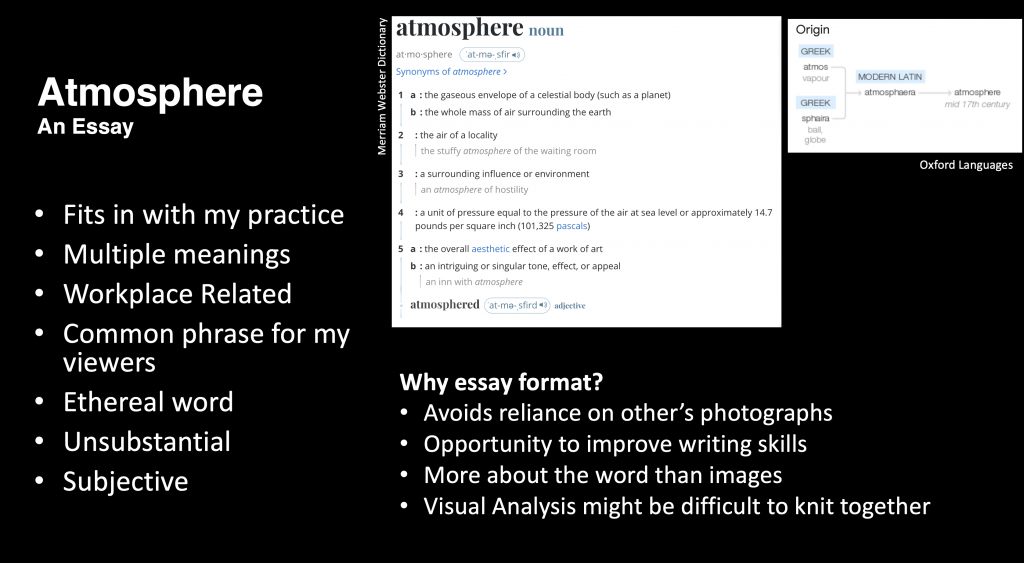
After the rest of the afternoon I figured out that I need to include on my presentation a list of areas that I will focus on. I did talk about the areas I’ll investigate in terms of the definition of the word atmosphere, how it is used in astronomy, what it means to have an atmosphere in life, and also in my workplace. The main reason I selected the word was due to people using it when looking at some of my photographs. Many people say that they like the creepy atmosphere in some of my photos.

This explanation will give my Plan some structure. Sylvia also mentioned that we can make the work more interesting by referencing films, games, books, and events etc.
Sylvia did also say that she was pleased that my plan was linking to my practice about liminal spaces and atmospheric looking pictures.
The Others
After my presentation, Ieva took her turn on the stage and discussed her word “Surface” and said that she’d be doing a visual analysis.
Noah then followed on and discussed how his plan about the word “Normal” would end up in an essay.
“Nostalgia” was the word chosen by Shellie and she also had a good plan on what might be in her essay etc.
Emma was linking her practice work to her word of “Time“
Beth didn’t stand and present but did discuss her choice of the word “Belonging” which had a very personal meaning.
Deconstruction and Reconstruction of portraits was Codey’s plan but she hadn’t selected a word as of yet. It was suggested that her word might be Deconstruct.
Once the presentations were completed and we had a discussion about the overall feeling we had from them all. We had a chat about the difference between Essay vs. Visual Analysis and how it is a selection of a couple of images that I feel relate to the chosen word and as we were discussing this I began to feel that my work might fit better into the visual analysis format than an essay. I will investigate this and look at using a visual analysis for my submission.
We then looked at the work of a previous student and examined their response to the artists library task, contextual essay plan, it was good to see how they approached the tasks and the quality of work. The work shown to us was graded in the 70% range, so it was good to see how a highly graded piece of work appeared.
Space
We watched a video by Dorothy Allen-Pickard titled “Three bodies”
In this video we see three women traversing their own spaces with their own histories and experiences. As Sylvia said, it invites us to think about our own spaces and how we move around it and interact with others, whether in a neutral, positive or negative way. It might be that somebody doesn’t want you in “their” space in a territorial style dispute or that you’re welcomed in and collaborated with to improve the outcomes for everyone.
The three women have different characteristics that they discuss, one is visually impaired, another has two prosthetic limbs and the other seems to experience visual stimulation overload. This last woman might be on the autistic spectrum from my limited knowledge. It shows how they all struggle with their own journeys across their spaces, each probably unaware of each other, and affected by other people in their own spaces.
It appears to me to be a video explaining that we are all different and you cannot always see what someone is experiencing in their everyday lives.
Sylvia has given us a link to another video about space in Angola.
Watching this video was strangely reminiscent of my feelings about the places that I photograph on a regular basis. De Miranda discusses that the spaces are beautiful and they’ve been allowed to fall into disrepair which is a shame. Her exhibition shows photographs of run down parts of the spaces she grew up in and has history with. She photographs a pair of twins in an old abandoned cinema/theatre and tells us that it represents the Past and the Present but if I’m honest I don’t actually understand a lot of her points. She talks in a way that sounds very arty and has some grand ideas that I can’t really get my head around. She shows us the video of the ballerina dancing in an old abandoned swimming pool area or luxury hotel and tells us that this is about a disconnect between the two, a contradiction and whilst I see the beauty in the images and videos, I do have difficulty in understanding it.
Social Science Bites: Doreen Massy on Space.
Sage YouTube Channel
An audio recording of an interview regarding Massey’s views on space. My notes:
- Doreen Massey is a Geographer that studies space.
- Spatial Relations is key to understand politics and power.
- Space is the dimension in which we live today.
- Space was not dynamic as in talks of space time, Time is the dynamic element.
- Space is not a flat surface, it’s a million stories wherever you stop.
- “Space is a cut through the myriad stories we all live in today.”
- “Time is a dimension of succession, space is a dimension of simultaneity” presents us with the dimension of the Other.
- “Time is ethereal and space is physical. Space concerns our relations with each other”
- Massey wants to ask political questions, and wants to be critical of unequal distribution of unequal distribution of power.
- Dimension of multiplicity helps us to open our minds to the different ways that people/countries etc want to develop or move forward. Developed/Underdeveloped/Developing countries.
- Occupy movement was a space related organisation
Reading the start of Part One: Setting the Scene.
Massey talks about the crusades of the Spanish conquistadors over the people of the Aztec empire. Rather than see the Aztec people or cities as a separate entity that has grown into what it was and learn lessons and spend time getting to learn off each other, they instead fought to conquer the Aztecs in an attempt to help them develop into more civilised societies.
This type of thinking has been seen throughout the world’s history and continues to occur to this day. Roman Empires, Japanese and Chinese Empires, Mongol Empire and even the British Empire and even today’s big organisations like the G20, NATO and United Nations. Massey argues that this thinking is a result of turning space into time, the Aztecs were “behind” the Spanish in terms of modernity. Words used by some racists today like “savages” still persist and continue to proffer that the only way is globalisation and capitalism like the Western “Developed” World has perfected.
Massey states that we might, more helpfully, think of space as a place existing on it’s own timeline and co-existing with everything else, and every other “place” around it.
For me, this is an experience I have when stuck in a long tailback on a motorway at night. I imagine that each car with the red lights in front of me is a capsule of someone’s life, their “Space”, whilst I sit in mine. What are they thinking in their car? Where have they been? Where are they going? What mood are they in? What music is on in their car? What job do they do? All of these questions go around my mind as I’m sitting in the queue feeling small and inconsequential. Except that to my family and friends I’m not small and inconsequential, I’m me, the person who provides wages, love, skills, humour, warmth and all manner of other characteristics. Every other person in their own cars has the same opportunity to be thinking the same.
The people in front of me in the queue are not simply ahead of me in space, due to being further down the road, or time, but they exist in the same moment that I do.
Massey’s hopes that the world’s politicians might learn to allow for differences in other countries/political spaces and that this will improve the conditions for everyone involved. To me it sounds like empathy and a willingness to think about how working together in a mutually beneficial manner will provide the best opportunities for all, rather than trying to railroad another country, people, group into an ideology or way of life by using violence or coercion.
TASK:
What does this text tell us about space? List 3 points that you can discuss in class.
1: Space is relative to the individual or group living within that space.
2: Different spaces are travelling along their own time line and forcing one spaces ideologies onto another usually leads to social dissonance.
3: Better understanding and flexible thinking around others’ space will usually be beneficial to those involved.
4: Just because the prominent idea (i.e. globalisation) leads, does not mean that others’ ideas are not as valid.
5: Space is the dimension in which we can talk to each other about differences without a need to change someone else’s’ views. Empathy and understanding grows in this way.
Be First to Comment